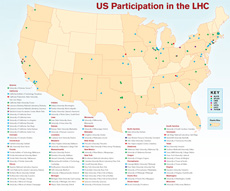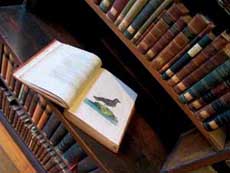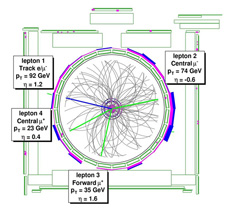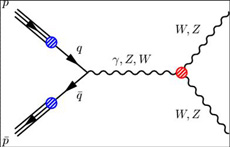|
Friday, Feb. 1
9 a.m.-3 p.m.
P5 meeting
Noon
Wellness Works Brown Bag Seminar - CANCELLED
Speaker: S. Brown, MD
Title: Easy Strategies for Weight Loss
2:30 p.m.
Particle Astrophysics Seminar - Curia II (NOTE DATE)
Speaker: K. Van Bibber, Lawrence Livermore National Laboratory
Title: Ultrasensitive Searches for the Axion
3 p.m. - 4:30 p.m.
P5 Town Hall meeting
4:30 p.m.
DIRECTOR'S COFFEE BREAK - 2nd Flr X-Over (NOTE TIME)
5 p.m.
Joint Experimental-Theoretical Physics Seminar - One West (NOTE TIME)
Speaker: E. Lipeles, University of California, San Diego
Title: Measurement of ZZ Production Cross Section at CDF
Monday, Feb. 4
2:30 p.m.
Particle Astrophysics Seminar - Curia II
Speaker: A. Dall'Aglio, Potsdam
Title: Quasars Ionizing Their Surroundings - A New Cosmological Tool
3:30 p.m.
DIRECTOR'S COFFEE BREAK - 2nd Flr X-Over
4 p.m
All Experimenters' Meeting - Curia II
Special Topic: COUPP Status in the MINOS Hall
Click here for NALCAL,
a weekly calendar with links to additional information. |
Friday, Feb. 1
- Old fashioned ham & bean
- Philly style chicken
- Braised pork chops
- Baked fish over rice
- Roasted veggie & provolone panini
- Assorted pizza slices
- Baked potato
Wilson Hall Cafe Menu |
|
Wednesday, Feb. 6
Lunch
- Northern Italian lasagna
- Caesar salad
- Cassata
Thursday, Feb. 7
Dinner
- Closed
Chez Leon Menu
Call x4598 to make your reservation. |
|
|
P5 Town Hall meeting at 3 p.m.
As part of the ongoing P5 meeting, which has open sessions from 9 a.m.-4:30 p.m. today, an open Town Hall meeting will take place from 3-4:30 p.m.
|
Across the ocean,
yet close to home

The newest issue of symmetry focuses on the Large Hadron Collider. To view the stories, visit the symmetry Web site.
Among the 10,000 people from around the world who are working on the Large Hadron Collider, 1000 hail from universities and national labs in the United States.
The Large Hadron Collider is the world's next-generation particle accelerator. Arguably the most ambitious scientific endeavor ever undertaken, the $8.7 billion project at CERN, the European particle physics lab in Geneva, Switzerland, has been in the works for more than two decades. When it begins operating in mid-2008, scientists predict that its very-high-energy collisions will yield extraordinary discoveries about the nature of the physical universe.
The LHC project has two equally important aspects: the collider itself and its six particle detectors, each one a self-contained experiment. The collider, nearing completion in a 27-kilometer ring deep below the Swiss-French border, will accelerate two beams of protons in opposite directions to a whisker below the speed of light. For most of their split-second journey around the ring, these hair-thin beams will travel in separate vacuum pipes; but at four points, in the hearts of the main experiments, they will collide at energies of 14 trillion electronvolts. These massive experiments-huge both in size and in worldwide participation-are known by their acronyms: ALICE, ATLAS, CMS, and LHCb. They are the tools physicists will use to turn particle collisions into scientific breakthroughs.
-- Katie Yurkewicz
Read more
|
Editing, analyzing, annotating, publishing: TextGrid takes the a, b, c to D-Grid

Using grid technology, scholars can access and re-use the work of their colleagues, opening new possibilities for collaborative and dynamic approaches to text science.
Image courtesy of TextGrid
A multitude of avid users are waiting to be introduced to grid technologies: scholars are semantically encoding and annotating texts, text scientists are researching the genesis of literature, digitization projects all over the globe are venturing to digitally capture our cultural heritage...
Such projects can sometimes span years, working in isolation on a single text, and together they have already accumulated terabytes of data.
Read more
-- Andreas Aschenbrenner, Goettingen State and University Library
|
Energy Under Secretary Orbach: "We are now at a perilous moment in the history of funding for science in the United States"
From AIP FYI, Jan. 31, 2008
In remarks delivered yesterday to the Universities Research Association, Energy Under Secretary for Science Raymond L. Orbach was clear: "Though you have heard this phrase before, we are now at a perilous moment in the history of funding for science in the United States."
Orbach's comments made it clear that legislative actions have real-world consequences: failure to enact the President's FY 2008 request for the Office of Science will be felt keenly in the research programs that the Office of Science supports. Reduced budgets will result in the elimination of funding for more than 4,300 Ph.D.'s, graduate students, and others from what was envisioned in the FY 2008 request.
Selections from Orbach's presentation follow; his entire speech may be found at the DOE Web site
Read more
|
|
|
CDF scientists create a buZZ
Experiment moves closer
to the Higgs boson

This event display shows a "side view" of the CDF Central Outer Tracker with a ZZ candidate event decaying into four muons. The thick green and blue lines indicate the high transverse momentum muon candidates.
For the first time at the Tevatron, CDF researchers have observed events produced in proton-antiproton collisions that resulted in the production of two Z bosons. This signal stands out from potentially mimicking background at a significance of 4.4 standard deviations. CDF collaborator Elliot Lipeles will present the result at a seminar directly following today's Town Meeting. The result highlights the rapidly increasing sensitivity of the Tevatron experiments to rare processes and is a major milestone toward the discovery of the Higgs boson.
The CDF collaboration reported these results in a paper submitted to Physical Review Letters earlier this week.
It was just one year ago that CDF announced the observation of WZ production -- a process expected to occur in only one of every 20 billion Tevatron collisions. Today's announcement of the rarer ZZ production demonstrates that researchers can now identify processes that occur only once per 60 billion collisions. This is an important step on the path toward observing the Higgs boson, which scientists anticipate is produced in approximately one out of every 200 billion Tevatron collisions if it is produced alone and has a mass of around 160 GeV/c2.
The Z boson is a gauge boson, a mediator of the electroweak force, a force that enables radioactive decay. The Z boson can serve as a powerful probe into the Standard Model's fundamental structure. In particular, studying ZZ events provides insight into the largely unexplored interactions of the gauge bosons with each other. A measurement of the ZZ cross section, or production probability in proton-antiproton interactions, could indicate that some of the Z boson pairs produced in Tevatron collisions result from the decay of a third Z boson or a photon. The interactions of three Z bosons with each other are not predicted by the Standard Model and would be a sign of new physics!
In their analysis of 1.9 inverse femtobarns of data, scientists found a handful of expected ZZ events. The chance of obtaining this result in the absence of ZZ production is approximately one in 200,000. CDF researchers measured a cross section of 1.4 ± 0.7 picobarns, which is consistent with the Standard Model.
With the ability to measure such a small cross section already in hand and more Tevatron data being collected every day, the next physics buzz could be much louder.

The proton and antiproton collide and create a photon or a Z or a W boson, which then produces two electroweak bosons. The frequency of production of these bosons provides insight into the Standard Model.
|
|
Have a safe day!
H1-B meeting at 9:30 a.m. today
Fermilab has posted an updated policy statement regarding the affects of furlough on H1-B visa holders. All H1-B supervisors and employees are encouraged to attend a meeting at 9:30 a.m. today in Ramsey Auditorium.
Employee Assistance Program
The January newsletters of the Employee Assistance Program are now available for employees and supervisors. The newsletters provide tips for the new year and information on the Employee Assistance Program, which is provided by VMC Behavioral Healthcare Services. Brian Malinowski, EAP counselor, is at Fermilab on Wednesdays and Fridays, x3591, brianm@fnal.gov. As an employee, you have 24-hour access to assistance, seven days a week by calling 1-800-843-1327.
Brown Bag Seminar CANCELLED
Sheron Brown, MD, will present a Brown Bag Seminar Friday, Feb. 1, from noon to 1 p.m. in Curia II entitled "Easy Strategies for Weight Loss."
Recreation class registration due Friday
Registration for the Muscle Toning Class must be submitted Friday for
the Feb. 5-28 class. The class costs $36 per person. You must be a current member of the gym to register.
Registration for Yoga must be submitted by Friday for the Feb. 5 to March 25 class. $80 per person.
Classifieds
New classified ads have been posted on Fermilab Today.
Additional Activities
|
|